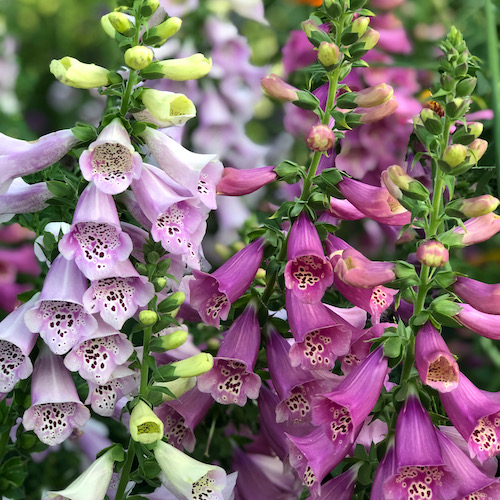If you’re a gardening enthusiast or a beginner looking to add some stunning blooms to your garden, the Digitalis plant, commonly known as Foxglove, is a fantastic choice. With its tall spikes of tubular flowers and enchanting appearance, the Digitalis plant can bring a touch of elegance and charm to any garden. In this blog post, we’ll explore everything you need to know about growing, caring for, and enjoying the beautiful Digitalis plant.
What is a Digitalis Plant?
Digitalis, commonly known as Foxglove, belongs to the Plantaginaceae family. This biennial or short-lived perennial is native to Europe, western Asia, and northwestern Africa. The plant is known for its tall flower spikes adorned with tubular, bell-shaped blooms in shades of pink, purple, white, and yellow. The name “Foxglove” is derived from the appearance of the flowers, which resemble the fingers of a glove.
Growing Digitalis – Tips for Success
Choosing the Right Location
Digitalis plants thrive in partial shade to full sun, making them versatile for various garden settings. However, they prefer a spot with some afternoon shade in hotter climates to prevent the flowers from wilting. Ensure the soil is well-draining, rich in organic matter, and slightly acidic to neutral (pH 6.0-7.0).
Planting Digitalis
- Sowing Seeds – Digitalis is typically grown from seeds. Sow the seeds indoors 8-10 weeks before the last frost date. Press the seeds lightly into the soil surface without covering them, as they need light to germinate. Keep the soil consistently moist until germination occurs, usually within 2-3 weeks.
- Transplanting Seedlings – Once the seedlings have developed a few true leaves, transplant them into the garden, spacing them 12-18 inches apart. If you prefer direct sowing, scatter the seeds in the desired location in early spring or fall.
Caring for Digitalis
- Watering – Keep the soil evenly moist, especially during dry periods. Avoid overhead watering to prevent fungal diseases. Water at the base of the plant to keep the foliage dry.
- Fertilizing – Digitalis plants benefit from a balanced, slow-release fertilizer applied in early spring. Avoid excessive nitrogen, as it can lead to lush foliage at the expense of flowers.
- Mulching – Apply a layer of organic mulch around the base of the plants to conserve moisture, suppress weeds, and regulate soil temperature.
- Deadheading – Remove spent flower spikes to encourage new blooms and prevent self-seeding. If you want the plant to self-seed, leave a few flower spikes intact.
Common Pests and Diseases
Digitalis plants are generally hardy, but they can be susceptible to certain pests and diseases:
- Aphids – These tiny insects can cluster on the flower spikes and leaves, causing distortion and sticky residue. Use insecticidal soap or a strong jet of water to control aphids.
- Powdery Mildew – This fungal disease appears as a white, powdery coating on the leaves. Ensure good air circulation around the plants and avoid overhead watering.
- Slugs and Snails – These pests can damage the foliage, especially during wet periods. Use slug bait or barriers to protect your plants.
Digitalis in the Garden – Design Tips
Digitalis plants are versatile and can be used in various garden designs:
- Cottage Gardens – Their tall, spiky blooms make them a perfect fit for cottage gardens, adding vertical interest and a touch of whimsy.
- Wildflower Meadows – Plant Digitalis among other wildflowers for a natural, meadow-like effect.
- Borders and Backdrops – Use Digitalis at the back of borders to create a stunning backdrop for shorter plants.
- Cut Flowers – Digitalis flowers make beautiful cut flowers for arrangements, adding height and drama to bouquets.
Safety Note – Toxicity
It’s important to note that all parts of the Digitalis plant are toxic if ingested. The plant contains compounds used in heart medication, but consuming any part of it can lead to serious health issues. Keep Digitalis out of reach of children and pets, and wear gloves when handling the plant to avoid skin irritation.
Conclusion
The Digitalis plant, with its striking flower spikes and vibrant colors, is a wonderful addition to any garden. By following these tips on growing, caring for, and designing with Digitalis, you can enjoy the beauty and elegance of this charming plant. Whether you’re creating a cottage garden, a wildflower meadow, or a stunning border, Digitalis will surely make a statement and bring joy to your garden.
For more gardening tips and inspiration, visit our unique gardening gifts collection and explore our wide range of gardening tools and accessories. Happy gardening!












You must be logged in to post a comment.